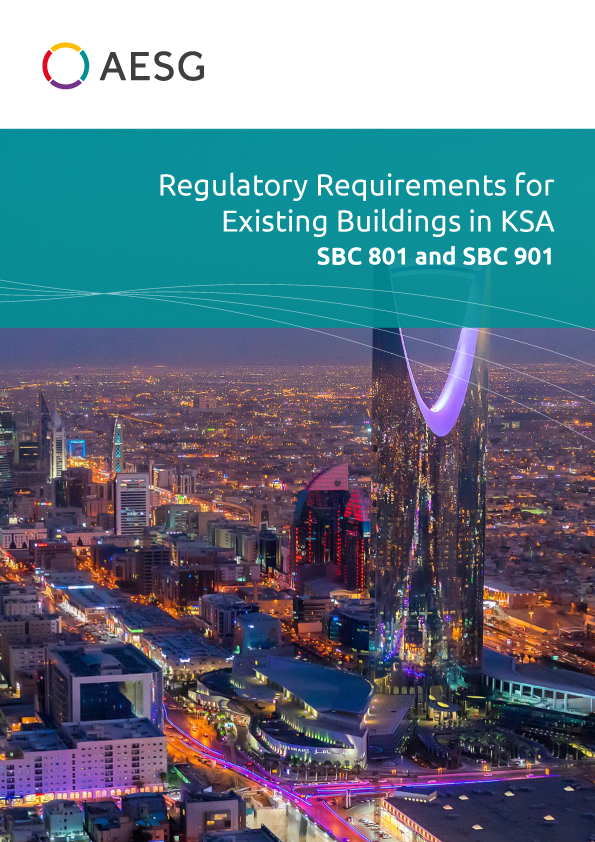
AESG has identified inconsistencies in the understanding and interpretation of code requirements related to existing buildings in KSA. This paper aims to provide clarity by presenting a high-level comparison of the two codes which address existing buildings, the Saudi Fire Code (SBC 801) and the Saudi Existing Building Code (SBC 901). Understanding the distinctions between these codes is crucial for ensuring compliance, enhancing safety measures, and improving the overall management of building safety standards.
Saudi Fire Code (SBC 801)
Applicability
Overall, the Saudi Fire Code (SBC 801) is designed to establish minimum requirements for the protection of life and property from fire for all buildings, both existing and new. As per Section 102.1, the construction and design provisions of this code shall apply to:
Chapter 11
Within SBC 801, Chapter 11 addresses existing building requirements. Compliance with this chapter is required for all existing buildings constructed prior to the adoption of SBC 801, or for any existing buildings deemed unsafe by the fire code official (Civil Defence). The intent of Chapter 11 is to provide a minimum degree of fire and life safety to persons occupying existing buildings where such existing buildings do not comply with the minimum requirements of the Saudi Building Code.
Saudi Existing Building Code (SBC 901)
Applicability
The Saudi Existing Building Code (SBC 901) focuses on the maintenance, alteration, and repair of existing buildings and historical buildings with valid permits. Existing buildings that never had or no longer have a valid permit are required to comply with SBC 201.
SBC 901 offers three routes to compliance:
The prescriptive method provides clear requirements for existing buildings to follow to obtain authority approvals, irrespective of the work being carried out. On the other hand, the Work Area Method provides varying levels of safety measures depending on the type and extent of work being carried out. Lastly, the performance compliance method aims to ensure that existing structures comply with safety standards while allowing for flexible, practical and cost-effective solutions.
Chapter 14 – Performance Compliance Method
Chapter 14 of SBC 901 contains provisions for an alternative method of evaluation of additions, alterations or changes of occupancy in existing buildings, which is based on a numerical scoring system involving various safety issues. Chapter 14 can be applied when the inspection and evaluation of the existing building is challenging, due to many of its features being concealed and inaccessible. Therefore, the performance compliance method allows the designer and the approving authority to rationally establish the safety of an existing building without having physical access to every part of the building, documentation of the original design or the construction history of the building. The assessment emphasises the evaluation of 21 critically important elements that can be easily quantified, such as means of egress, the provision of suppression systems, the provision of detection and alarm systems, and more.
The Saudi Fire Code (SBC 801) and the Saudi Existing Building Code (SBC 901) serve distinct but complementary roles in ensuring building safety in Saudi Arabia. SBC 801 mostly sets the foundation for fire safety in new constructions, except for Chapter 11 which relates to existing buildings; whereas SBC 901 is intended exclusively for existing buildings, ensuring that they are maintained and adapted to meet appropriate standards of safety.
The key difference between the two codes is that while SBC 801 (Chapter 11) sets the minimum standards of safety for all existing buildings, SBC 901 applies only to buildings undergoing some form of change, such as an alteration, repair, or change of occupancy. Moreover, while SBC 801 takes a prescriptive approach, SBC 901 allows flexibility in meeting safety standards by permitting a performance compliance method (Chapter 14).
AESG has adopted the following approach for existing building in KSA:
All existing buildings shall be evaluated against the minimum requirements of SBC 801 Chapter 11.
Any existing building with a valid permit may adopt the methodologies of SBC 901 to implement alterations, modifications, repairs and renovations.
All existing buildings shall be evaluated against the minimum requirements of SBC 801 Chapter 11.
Any existing building with a valid permit may adopt the methodologies of SBC 901 to implement alterations, modifications, repairs and renovations.
Existing buildings which are legally occupied and were constructed prior to the implementation of the Saudi Building Codes, may be evaluated against SBC 801 and SBC 901, as required.
Existing buildings which do not have a valid permit and which have not been previously occupied are required to comply with the Saudi Building Code (SBC 201).
Existing buildings which are legally occupied and were constructed prior to the implementation of the Saudi Building Codes, may be evaluated against SBC 801 and SBC 901, as required.
Existing buildings which do not have a valid permit and which have not been previously occupied are required to comply with the Saudi Building Code (SBC 201).
AESG is an international Consultancy, Engineering and Advisory firm committed to driving sustainability in the built environment and beyond. With the highest calibre leadership team in our field, we pair technical knowledge with practical experience to provide hands-on, bespoke strategic solutions to our clients.
We have one of the largest dedicated specialist consultancy teams working on projects within the building, urban planning, infrastructure and strategic advisory sectors. With decades of cumulative experience, our team offers specialist expertise in sustainable design, sustainable engineering, MEPF, fire and life safety, façade engineering, commissioning, digital delivery, waste management, environmental consultancy, strategy and advisory, security consultancy, cost management and acoustics. Our prestigious portfolio demonstrates our extensive capabilities and our ability to consistently deliver best in class solutions to some of the industry’s most complex technical challenges.

Senior Associate Consultant – Fire & Life Safety, AESG
James is the Senior Associate FLS Consultant at AESG. He holds a Masters Degree in Architectural Engineering from the University of Leeds (UK) and has 8 years of experience working in the Fire Protection and Fire and Life Safety industry.
James enjoys working in a multidisciplinary team environment to find tailored and practical solutions for all stakeholders. James specialises in the development of fire and life safety strategies using both prescriptive and performance-based approaches. Moreover, he is experienced in the design of fire protection systems and in application of computational fluid dynamics (CFD).
James has experience across a diverse range of projects including residential apartments, hotels, offices, healthcare buildings, shopping malls and masterplan developments. Experience includes projects in Middle East, Europe, North America and Asia.
For further information relating to specialist consultancy engineering services, feel free to contact us directly via info@aesg.com

ISO 27001:2022
ISO 9001:2015
ISO 14001:2015
ISO 45001:2018
Whistleblower Policy
Cayan Business Tower
3rd, 6th & 11th Floor
Barsha Heights
P.O. Box 2556
Dubai, United Arab Emirates
T / +971 (0) 4 432 6242
305 Mermaid House
2 Puddle Dock
London, EC4V 3DS
United Kingdom
T / +44 (0) 208 037 8762
Haibu Space, Abu Dhabi Mall
1st floor, Office 37
Tourist Club Area
Abu Dhabi, United Arab Emirates
T / +971 (0) 2 201 2527
9391 Wadi Al Thummamah
2444 Al Olaya District
PO Box 12214
Riyadh, Kingdom of Saudi Arabia
T / +966 (0) 112 278 288
111 Somerset Road
#08-10A, 111 Somerset
Singapore 238164
11th Floor, Office 1101
2 Long Street
Cape Town 8000
Western Cape, South Africa
T / +27 (0) 21 137 6444
8 Parramatta Square
49th Floor, Office 117
Parramatta, Sydney
New South Wales 2150
Australia
T / +61 (0) 2 8042 6817
Regus Rialto, West Podium
Level Mezzanine 2 (M2)
525 Collins Street
Melbourne, Victoria 3000
Australia
Regus Egypt, East Lane
1st Floor, Office 130
Plot number B-340
New Cairo 1
Cairo Governorate 4740003
Egypt
Cayan Business Tower
3rd, 6th & 11th Floor
Barsha Heights
P.O. Box 2556
Dubai, United Arab Emirates
T / +971 (0) 4 432 6242
305 Mermaid House
2 Puddle Dock
London, EC4V 3DS
United Kingdom
T / +44 (0) 208 037 8762
Office 37, Haibu Space
1st floor, Abu Dhabi Mall
Tourist Club Area
Abu Dhabi, United Arab Emirates
T / +971 (0) 2 201 2500
9391 Wadi Al Thummamah
2444 Al Olaya District
PO Box 12214
Riyadh, Kingdom of Saudi Arabia
T / +966 (0) 112 278 288
111 Somerset Road
#08-10A, 111 Somerset
Singapore 238164
WeWork, 80 Strand St
Cape Town City Centre
Cape Town, 8001
South Africa
T / +27 21 137 6444
49th Floor, Office No.117
8 Parramatta Square
Parramatta, Sydney
New South Wales 2150
Australia
T / +61 (0) 2 8042 6817
Regus Rialto, West Podium
Level Mezzanine 2 (M2)
525 Collins Street
Melbourne, Victoria 3000
Australia
Enawalks, 4th Floor, Office 417
Leaders International College Road
2F97+6VJ New Cairo 1
Cairo Governorate 4724242
Egypt
T / +20 15 01692187